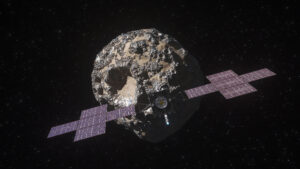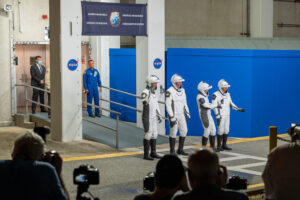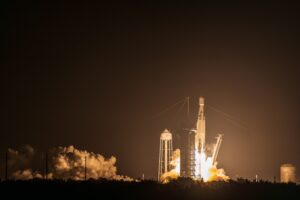It was a long day-the longest day of the year in the Northern Hemisphere in fact, when Cosmic Perspective photographer John Pisani recorded the offloading of the Atlas V booster and Centaur upper stage. This rocket will launch the Starliner crewed flight test by United Launch Alliance (ULA), a collaboration between Boeing and Lockheed Martin that has over 140 consecutive successful launches.

Photo credit: John Pisani for Cosmic Perspective
The Centaur upper stage photographed here will be mated to the Starliner spacecraft, Calypso. The upcoming crewed launch of the vehicle pictured here will be the first launch of humans on an AtlasV rocket. This crewed flight test will be Boeing’s first crewed test flight, and is now targeted for no earlier than (NET) late 2021. The crew of 3 astronauts has already been selected for the demo mission, and includes Barry Billmore (Commander), Michael Fincke (Pilot) and Nichole Anuapu Mann (Mission Specialist).
Video credit: John Pisani for Cosmic Perspective
Calypso is being re-used from its first launch -on nearly the shortest day of the year in the Northern Hemisphere- December 20th, 2019. The space capsule was Boeing’s first attempt to dock with the International Space Station (ISS). Unfortunately, Calypso failed its primary objective of docking with the ISS due to a software glitch. An onboard clock was off by 11 hours, and one result was the spacecraft used up much of its fuel too soon, making it impossible to reach the correct orbit to dock with the ISS. Another glitch was found just before the reentry sequence was commanded, which could have potentially damaged the Starliner capsule before its return to Earth. The second glitch would not have been found if the first glitch had not happened.
The launch of a crewed Starliner depends on a successful test dubbed OFT-2 (Orbital Flight Test 2) scheduled to launch July 30, 2021. OFT-2 will be the second attempt by Boeing to dock with the ISS. OFT-2 is currently testing and will soon be “stacked” in preparation for launch. It has been a very long year for Boeing. The OFT-2 mission is an expensive mulligan for Boeing, where they must prove the Starliner’s ability to dock with the ISS and return safely before NASA will allow a flight on this hardware and software design with astronauts on board. Boeing’s website for Starliner now features articles such as “Code For Succes” and “Verifying Software Safety” and highlights a successful “end to end” 110 hour simulation of the upcoming uncrewed demo mission.
SpaceX, Boeing’s direct competitor in NASA’s Commercial Crew Program, has had its share of close calls as well. On April 20, 2019, the unoccupied Crew Dragon that had just returned to Earth from the ISS exploded during ground testing. The problem was discovered to be with a pressurization tank, not an issue with the engines, but had this explosion happened while the Dragon capsule was docked or near the ISS, the result would have been catastrophic. Earlier testing of the Dragon capsule uncovered several issues with the parachute system which were corrected, but not without the loss of one “test article”. The Dragon capsule was originally designed to land safely without parachutes, but that challenge has been left for later iterations.
On May 30, 2020, SpaceX returned launch capability back to the United States with the successful launch of a Crew Dragon named Demo-2, a crewed mission to the ISS. The crew (Douglas Hurley and Robert Behnken) returned safely back to Earth on August 2, 2020. Boeing’s Crew Starliner and SpaceX’s Crew Dragon are both part of NASA’s Commercial Crew Program’s design to eliminate the United States’ reliance on Russian spacecraft for human launch capabilities.
The crew of Boe-CFT is eagerly awaiting the successful completion of OFT-2, so that NASA has reassurance that there are two local, viable methods to get to and return from the ISS safely. We are watching and holding our breath as well for the success, failures, excitement, challenges, history, and future of space exploration and reflection, and for the long and short days that hold these Cosmic Perspectives.
Perviously, in NASA's Commercial Crew Program
In December of 2019, NASA’s Commercial Crew astronauts and the previous NASA Administrator, Jim Bridenstine, addressed the public during a pre-launch press conference just before Starliner’s maiden flight. The Administrator shared his enthusiasm to return human spaceflight capabilities to U.S. soil, and the astronauts shared thoughts on this new era of commercial spaceflight which paves the way for private citizens to join them in space.
On March 2, 2019, SpaceX launched Crew Dragon’s first demonstration mission, officially kicking off NASA’s Commercial Crew Program. The Falcon 9 rocket successfully launched the Crew Dragon to the International Space Station for an uncrewed flight on the DM-1 mission. Once docked to the Station, NASA Astronaut Anne McClain conducted a heart-warming welcome ceremony to properly usher in this “new era of spaceflight.”



